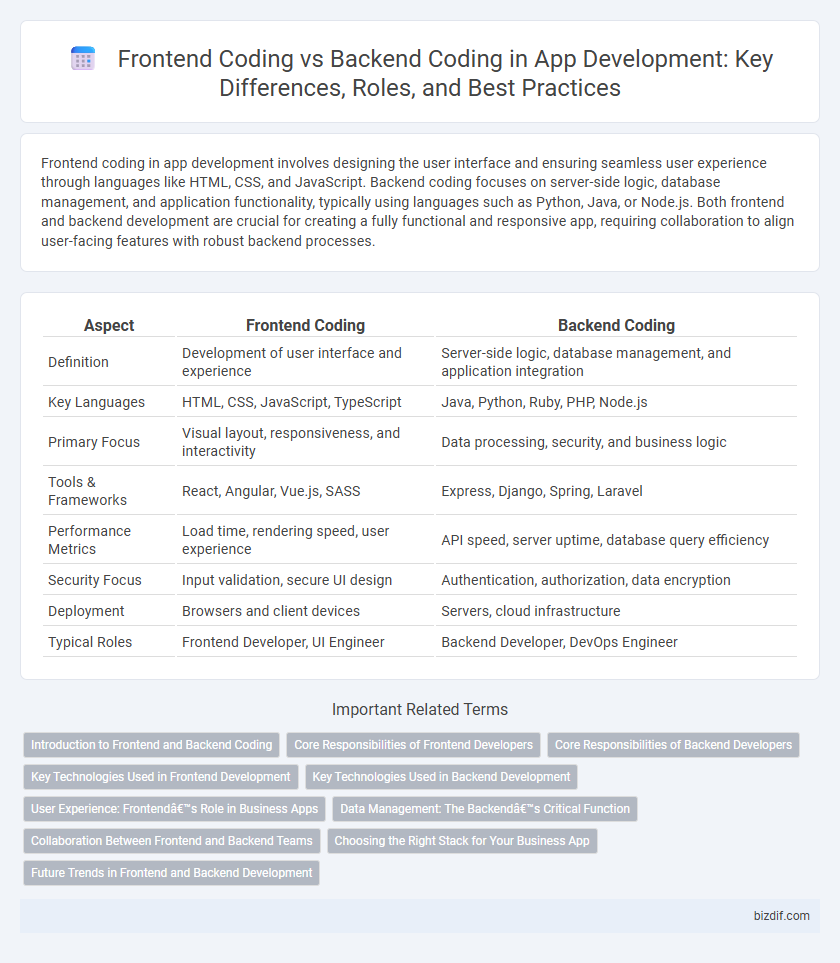Frontend coding in app development involves designing the user interface and ensuring seamless user experience through languages like HTML, CSS, and JavaScript. Backend coding focuses on server-side logic, database management, and application functionality, typically using languages such as Python, Java, or Node.js. Both frontend and backend development are crucial for creating a fully functional and responsive app, requiring collaboration to align user-facing features with robust backend processes.
Table of Comparison
| Aspect | Frontend Coding | Backend Coding |
|---|---|---|
| Definition | Development of user interface and experience | Server-side logic, database management, and application integration |
| Key Languages | HTML, CSS, JavaScript, TypeScript | Java, Python, Ruby, PHP, Node.js |
| Primary Focus | Visual layout, responsiveness, and interactivity | Data processing, security, and business logic |
| Tools & Frameworks | React, Angular, Vue.js, SASS | Express, Django, Spring, Laravel |
| Performance Metrics | Load time, rendering speed, user experience | API speed, server uptime, database query efficiency |
| Security Focus | Input validation, secure UI design | Authentication, authorization, data encryption |
| Deployment | Browsers and client devices | Servers, cloud infrastructure |
| Typical Roles | Frontend Developer, UI Engineer | Backend Developer, DevOps Engineer |
Introduction to Frontend and Backend Coding
Frontend coding involves creating the visual interface and interactive elements of an application using technologies like HTML, CSS, and JavaScript to ensure seamless user experience and responsive design. Backend coding focuses on server-side logic, databases, and application functionality using languages such as Python, Java, or Node.js to manage data processing, authentication, and server communication. Understanding the distinct roles and technologies of frontend and backend development is essential for building fully functional, efficient, and user-friendly applications.
Core Responsibilities of Frontend Developers
Frontend developers specialize in designing and implementing the visual elements of an application, ensuring responsive layouts, intuitive user interfaces, and seamless interactivity using HTML, CSS, and JavaScript frameworks like React or Angular. Their core responsibilities include optimizing user experience, managing client-side logic, and integrating APIs to fetch and display dynamic content. They also focus on cross-browser compatibility, accessibility standards, and performance enhancements to deliver fast and engaging applications.
Core Responsibilities of Backend Developers
Backend developers primarily manage server-side logic, database interactions, and application architecture to ensure seamless data flow and system functionality. They implement APIs, handle authentication, and maintain server performance to support frontend operations. Their expertise in languages like Python, Java, and Node.js, along with database management using SQL or NoSQL, is essential for building scalable, secure applications.
Key Technologies Used in Frontend Development
Frontend development primarily utilizes HTML, CSS, and JavaScript to create user interfaces and enhance user experience. Frameworks and libraries like React, Angular, and Vue.js enable dynamic and responsive web applications through component-based architecture and efficient state management. Tools such as Sass for advanced styling, Webpack for module bundling, and Babel for JavaScript transpiling are essential in optimizing frontend code performance and compatibility.
Key Technologies Used in Backend Development
Backend development relies heavily on technologies like Node.js, Python with Django or Flask, Ruby on Rails, and Java with Spring Boot to build server-side logic and manage databases efficiently. Key components include RESTful APIs, server frameworks, relational databases like MySQL and PostgreSQL, as well as NoSQL options such as MongoDB. Cloud platforms and containerization tools like AWS, Docker, and Kubernetes also play a crucial role in deploying scalable backend services.
User Experience: Frontend’s Role in Business Apps
Frontend coding directly shapes the user experience by creating intuitive and responsive interfaces that engage users and facilitate seamless interactions with business applications. Effective frontend development harnesses technologies like React, Angular, and Vue.js to enhance usability and accessibility, which drives user satisfaction and retention. Prioritizing frontend design in business apps ultimately boosts operational efficiency by enabling users to complete tasks swiftly and accurately.
Data Management: The Backend’s Critical Function
Backend coding plays a crucial role in data management by securely storing, processing, and retrieving information from databases. It handles server-side logic, ensuring data integrity and efficient API communication between the frontend and database servers. Robust backend frameworks like Node.js, Django, or Ruby on Rails optimize data workflows and support scalable application architecture.
Collaboration Between Frontend and Backend Teams
Effective collaboration between frontend and backend teams ensures seamless integration of user interfaces with server-side logic, enhancing overall app functionality. Utilizing APIs and clear data contracts facilitates smooth communication and reduces development bottlenecks. Emphasizing shared tools like version control systems and continuous integration platforms accelerates coordinated updates and bug fixes.
Choosing the Right Stack for Your Business App
Selecting the right tech stack for your business app depends on factors like scalability, performance, and user experience. Frontend coding focuses on designing intuitive interfaces with frameworks like React or Vue.js, while backend coding handles server logic, databases, and APIs using technologies such as Node.js, Python, or Ruby on Rails. Evaluating your app's requirements and long-term goals ensures a balanced stack that optimizes both frontend responsiveness and backend reliability.
Future Trends in Frontend and Backend Development
Future trends in frontend development emphasize progressive web apps, component-based frameworks like React and Vue.js, and enhanced user experiences through AI-driven personalization. Backend development increasingly leverages microservices architecture, serverless computing, and integration of blockchain technology for improved scalability and security. Both frontend and backend advancements prioritize seamless cloud integration and real-time data processing to support modern app demands.
Frontend Coding vs Backend Coding Infographic

 bizdif.com
bizdif.com